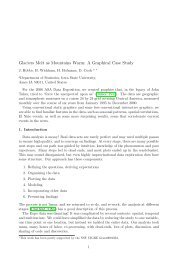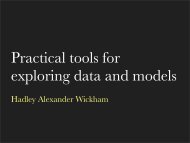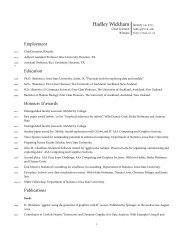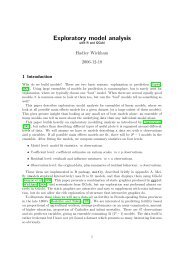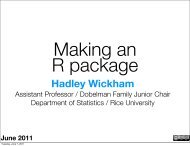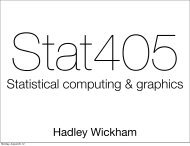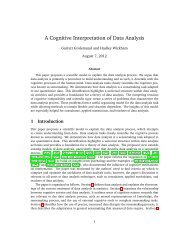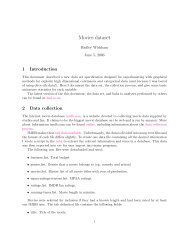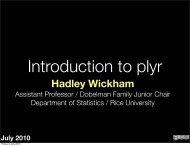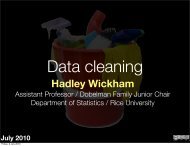Statistical inference for exploratory data analysis ... - Hadley Wickham
Statistical inference for exploratory data analysis ... - Hadley Wickham
Statistical inference for exploratory data analysis ... - Hadley Wickham
Create successful ePaper yourself
Turn your PDF publications into a flip-book with our unique Google optimized e-Paper software.
<strong>Statistical</strong> <strong>inference</strong> <strong>for</strong> graphics 4369<br />
administrator would not know whether or not the <strong>data</strong> analyst encountered the<br />
real <strong>data</strong>, while the <strong>data</strong> analyst would be kept alert because of the possibility<br />
of encountering the real <strong>data</strong>. With careful handling, the <strong>data</strong> analyst can in<br />
principle self-administer the protocol and resort to a separation of roles with an<br />
externally recruited <strong>data</strong> analyst only in the case of inadvertent exposure to the<br />
plot of the real <strong>data</strong>.<br />
While the details of the protocol may seem excessive at first, it should be<br />
kept in mind that the rigour of today’s clinical trials may seem excessive to the<br />
untrained mind as well, and yet in clinical trials this rigour is accepted and heavily<br />
guarded. Data analysts in rigorous clinical trials may actually be best equipped to<br />
work with the proposed protocol because they already adhere to strict protocols<br />
in other contexts. Teaching environments may also be entirely natural <strong>for</strong> the<br />
proposed protocol. Teachers of statistics can put themselves in the role of the<br />
administrator, while the students act as <strong>data</strong> analysts. Such teaching practice of<br />
the protocol would be likely to efficiently develop the students’ understanding of<br />
the nature of structure and of randomness.<br />
In the practice of <strong>data</strong> <strong>analysis</strong>, a toned-down version of the protocol may<br />
be used as a self-teaching tool to help <strong>data</strong> analysts gain a sense <strong>for</strong> spurious<br />
structure in <strong>data</strong>sets of a given size in a given context. The goal of the training<br />
is to allow <strong>data</strong> analysts to in<strong>for</strong>mally improve their family-wise error rate and<br />
develop an awareness of the features they are most likely to spuriously detect.<br />
The training is of course biased by the analysts’ knowledge that they are looking<br />
exclusively at null plots. In practice, however, the need <strong>for</strong> looking at some null<br />
plots is often felt only after having looked at the plot of the real <strong>data</strong> and having<br />
found merely weak structure. Even in this event, the practice of looking at null<br />
plots is useful <strong>for</strong> gauging one’s senses, though not valid in an inferential sense.<br />
Implementing this protocol would effectively mean inserting an initial layer into<br />
a <strong>data</strong> <strong>analysis</strong>—be<strong>for</strong>e the plot of the real <strong>data</strong> is revealed a series of null plots<br />
is shown.<br />
5. Protocol 2: ‘the lineup’<br />
We call the second protocol ‘the lineup’, after the ‘police lineup’ of criminal<br />
investigations (‘identity parade’ in British English), because it asks the witness to<br />
identify the plot of the real <strong>data</strong> from among a set of decoys, the null plots, under<br />
the veil of ignorance. The result is an inferentially valid p-value. The protocol<br />
consists of generating, say, 19 null plots, inserting the plot of the real <strong>data</strong> in<br />
a random location among the null plots and asking the human viewer to single<br />
out one of the 20 plots as most different from the others. If the viewer chooses<br />
the plot of the real <strong>data</strong>, then the discovery can be assigned a p-value of 0.05<br />
(=1/20)—under the assumption that the real <strong>data</strong> also <strong>for</strong>m a draw from the<br />
null hypothesis there is a one in 20 chance that the plot of the real <strong>data</strong> will be<br />
singled out. Obviously, a larger number of null plots could yield a smaller p-value,<br />
but there are limits to how many plots a human viewer is willing and able to sift<br />
through. This protocol has some interesting characteristics.<br />
(i) It can be carried out without having the viewer identify a distinguishing<br />
feature. The viewer may simply be asked to find ‘the most special picture’<br />
among the 20, and may respond by selecting one plot and saying ‘this<br />
Phil. Trans. R. Soc. A (2009)<br />
Downloaded from<br />
rsta.royalsocietypublishing.org on January 7, 2010



